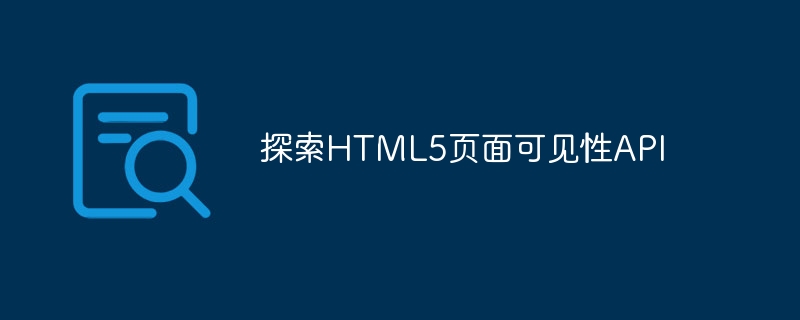

Earlier our browsers did not have tabbed browsing feature but today when you check all available browsers we can see that all browsers provide This function. As a programmer, I usually have 10-15 tabs open at a time, and sometimes this number exceeds 25-30.
Previously, it was impossible to determine which tab was active and which tab was active, but with the help of the HTML5 Visibility API, we can detect whether a visitor is viewing our web page.
In this tutorial, we will learn how to deal with the HTML5 Visibility API and a simple demonstration to discover the state of the page. In this demo, we will change the document title based on the page visibility state.
With the introduction of this API, we welcome two new document properties that serve two different functions. The first is document.visibilityState and the second is document.hidden.
document.visibilityState contains four different values as follows:
document.hidden is a Boolean property that is set to false if the page is visible and set to true if the page is hidden.
Now we can control how our website behaves when it is hidden from users.
We know our availability property right away, but now it's time to listen to the event so that we can be notified of new situations regarding the page's visibility. This is done via the visibilitychange event. We'll see a quick demonstration on how to handle this event.
document.addEventListener('visibilitychange', function(event) {
if (!document.hidden) {
// The page is visible.
} else {
// The page is hidden.
}
});
This code is just a basic example of utilizing this event and discovering the current state of the web page. But just so you know, these properties and methods should all use vendor prefixes because these events and properties are vendor-prefixed in some browsers. Now we'll see the same code cross-browser:
// Get Browser-Specifc Prefix
function getBrowserPrefix() {
// Check for the unprefixed property.
if ('hidden' in document) {
return null;
}
// All the possible prefixes.
var browserPrefixes = ['moz', 'ms', 'o', 'webkit'];
for (var i = 0; i < browserPrefixes.length; i++) {
var prefix = browserPrefixes[i] + 'Hidden';
if (prefix in document) {
return browserPrefixes[i];
}
}
// The API is not supported in browser.
return null;
}
// Get Browser Specific Hidden Property
function hiddenProperty(prefix) {
if (prefix) {
return prefix + 'Hidden';
} else {
return 'hidden';
}
}
// Get Browser Specific Visibility State
function visibilityState(prefix) {
if (prefix) {
return prefix + 'VisibilityState';
} else {
return 'visibilityState';
}
}
// Get Browser Specific Event
function visibilityEvent(prefix) {
if (prefix) {
return prefix + 'visibilitychange';
} else {
return 'visibilitychange';
}
}
We have all the browser prefix properties and the events are ready to be applied. Now we will change the previous code accordingly.
// Get Browser Prefix
var prefix = getBrowserPrefix();
var hidden = hiddenProperty(prefix);
var visibilityState = visibilityState(prefix);
var visibilityEvent = visibilityEvent(prefix);
document.addEventListener(visibilityEvent, function(event) {
if (!document[hidden]) {
// The page is visible.
} else {
// The page is hidden.
}
});
We can consider using this API in many different scenarios.
So far we've seen the code that uses the HTML5 Page Visibility API, it's time to take some immediate action.
In this demo we will look at how to restrict polling the server for the latest information, but only while the user is viewing the page. I'm assuming jQuery is already included in your page. Here we will just increment the count, but this could be replaced with real server polling.
<!-- This element will show updated count --> <h1 id="valueContainer">0</h1>
<script type="text/javascript">
// Get Browser Prefix
var prefix = getBrowserPrefix();
var hidden = hiddenProperty(prefix);
var visibilityState = visibilityState(prefix);
var visibilityEvent = visibilityEvent(prefix);
var timer = null;
function increaseVal() {
var newVal = parseInt($('#valueContainer').text()) + parseInt(1);
$('#valueContainer').text(newVal);
document.title = newVal + ': Running';
timer = setTimeout(function() {
increaseVal();
}, 1);
}
// Visibility Change
document.addEventListener(visibilityEvent, function(event) {
if (document[hidden]) {
clearTimeout(timer);
var val = parseInt($('#valueContainer').text());
document.title = val + ': Pause';
} else {
increaseVal();
}
});
increaseVal();
</script>
Demo view
If you want to see browser support for this API, then I recommend checking out Can I use it? . But to find browser support programmatically, I recommend reading this article to detect support for various HTML5 features. So far, we have good support for this API in almost all major and latest browsers.
I would like to say that we have a very good API that only consists of two properties and an event. This way, it can be easily integrated with your existing applications, which may have a positive impact on your user experience. Finally, now we can control how our sites behave when they are hidden from users.
The above is the detailed content of Explore the HTML5 Page Visibility API. For more information, please follow other related articles on the PHP Chinese website!




